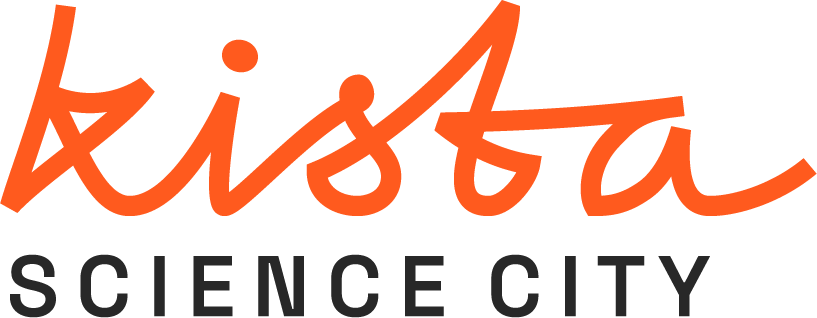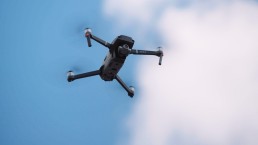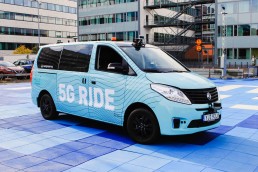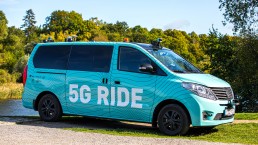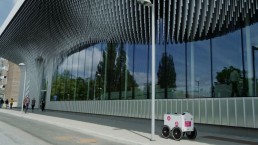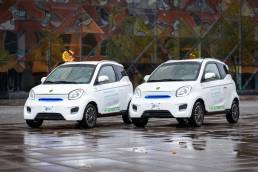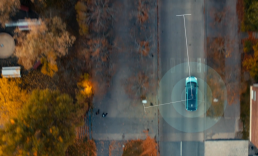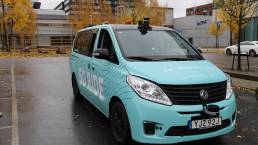Kista takes the lead in smart drone services
Kista takes the lead in smart drone services
Drones will soon be serving customers, citizens, businesses, and authorities with a wide range of revolutionary new services.
Kista Science City hosts one of Sweden’s largest knowledge clusters when it comes to new mobility. A new project will prepare cities for the next phase in this fast-growing drone economy. The tech scene in Stockholm has millions of reasons to get excited.
Drone-based services are expected to be game-changing in the coming years: The potential is enormous in areas as medical transport, emergency response, traffic monitoring and delivery of food and packages, just to name a few. On top of that: using drones can be both effective and sustainable.
But implementing this at a large scale is complex. While the technology for drone services advances quickly, the ecosystem needed for the” lower airspace mobility revolution” isn’t in place. Yet.
That’s what’s most probably about to change in the upcoming years, as the drone market is expected to boom by 2030.
Funding, expertise and tests
Stockholm will take a leading role in a three-year project to identify, test, and evaluate solutions linked to urban drone services in European cities.
The goal is to develop tools for adapted urban planning, to evaluate lifting and landing sites in an urban environment, and to build an ecosystem that pave the way for drone traffic to become part of a multimodal transport system.
The City of Stockholm is collaborating with Kista Science City and the Swedish Air Navigation Services in a consortium that will be focusing on funding, expertise, and implementation of tests.
– New strategies and tools are needed to be able to handle the increasing number of drones in urban areas. We are extremely proud that Stockholm has been selected as one of three European cities to actively lead the development of shaping the future of mobility, says Karin Bengtsson, CEO, Kista Science City.
Contact us if you want to be part of the new drone economy
If you are a tech startup developing products or services related to drones, contact us (Eleonor Sjödin Turah), to be in the loop.
The startup Aerit is one of the tech companies part of this fast-growing eco-system. Founder and CEO, Alexander Perrien, feels the vibrating excitement for drone services in Kista:
– Most companies we have met understand the immense economic and social value autonomous robots can bring and are actively working on solutions and supporting products, he says.
Drones bring endless potential for society
Alexander paints a picture of almost endless potential for society as it fully taps into the possibilities:
– Drones themselves are essentially highly mobile sensor suites, and there is little that prevents us from offering the data we collect as a service in the future. Imagine on the way back from dropping off groceries to a local balcony, the drone stops by a local water reservoir to scan for excess nutrients, sample the air near a local production facility, or update a 3D map of new development. Highly accurate hyper-local data can be provided on demand.
– We are building a future where, at the tap of a button, businesses and individuals alike can send anything anywhere around the globe through a series of coordinated purpose-built autonomous solutions.
About the project “Preparing Cities for Air Mobility – CITYAM
* 13 partners from industry, academia, and cities collaborate on behalf of the Interreg Baltic Sea Region. Over three years, these will test, evaluate, and prepare sustainable solutions for lower airspace mobility in Europe’s cities.
* Stockholm will have a leading role together with Helsinki and Hamburg.
* Lars Strömgren, traffic commissioner in the Stockholms stad says: ”The capital of Sweden must be equipped for future mobility services. The development of drone deliveries is going at rocket speed right now. Therefore, we will investigate how drones could best be used in Stockholm and what rules they would require. We will also develop a plan for possible landing sites and carry out a pilot project with drones in an urban environment.”
* Billy Josefsson, Research & Innovation Urban Air Mobility, Luftfartsverket, says: ”This is really good for the industry, we need champions like the City of Stockholm. The arguments, needs for competence, and solutions identified in CITYAM and for Stockholm will be a valuable contribution to the entire national transition of gradually introducing technology, formulating rules and starting to use drone services. There is so much societal benefit to be gained, the challenge ahead is to build competence and to find good forms of collaboration between the actors.”
Seeing through obstacles and around corners, the 5G Ride project rolls on
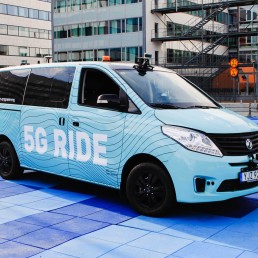
Drones
Seeing through obstacles and around corners, the 5G Ride project rolls on
The 2022 5G RIDE Demo Day on October 13 gathered more than 50 special invited guests and project partners who got a sneak preview of the latest technology updates.
This year’s demonstration focused on how new technology can be used to increase safety and security around autonomous vehicles in commuting traffic, hence offering a safer experience for travellers and other road users. The visitors got to experience how smart sensors on vehicles and in the surrounding infrastructure makes it possible for the vehicle to see through obstacles and around corners.
The sensors are an important addition to the project, as they measure positions and paths/route for all road users and sends this data in real time to Ericsson Innovation cloud, via 5G, where the data is processed, combined with other sources, and shared with the connected vehicle. The vehicle is acting upon the combined picture, from sensors, traffic tower, own cameras and the surrounding. In real time. During the demonstration we could see what happens if a person crosses the street if there is an obstacle on the path and how buildings and people are plotted on the onboard screens.
The technology enabling this is the 5G network and the traffic tower, as they fetch and share real-time data from the vehicle.
The ambition of the 5G RIDE project is to create conditions for an efficient and sustainable public transport where operators in traffic towers can support fleets of autonomous, electric vehicles to improve traffic planning, safety and reduce energy consumption. By taking a unified approach and combining technologies, the next step in the development of driverless automated vehicles is taken.
This project takes place in a collaboration between some of Sweden’s leading companies in mobility and technology. Kista Science City AB, Keolis, Ericsson, Telia, T-engineering, Viscando, Scania, Region Stockholm, intel and KTH. Working together to create a more environmentally smart and cost-efficient transport system.
For more information about the project
project manager Eleonor Sjödin Turah
eleonor.sjodinturah@kista.com
Sign up to get the latest news, updates and insights from Kista Science City
5G Ride
5G Ride
Autonomous vehicles
The project
5G Ride is a concept for self-driving, 5G-connected electric vehicles used in public transport.
The purpose of the project is to develop and test connected autonomous vehicles to get closer to an implementation of autonomous vehicles on public roads.
The 5G network’s unique technical features, including enhanced security, extremely high data speeds combined with low latency, means that the connected buses can respond in real time to commands from the centralized control tower.
In 2021, additional funding was added to the project and the focus for the continuation of the project is the further development of the Connected Control Tower. One part of this is how to use more data, for example about the route, the vehicle or the connection strength, to make it possible to prevent any problems, plan routes and schedules better and act more swiftly should problems arise.
Project period
2020-2025
Partners
Keolis
Ericsson
Telia
Intel
Scania
Viscando
T-Engineering
Royal Institute of Technology
City of Stockholm
Region Stockholm
KTH
AppliedAutonomy
VY
Contact
Eleonor Sjödin Turah
eleonor.sjodinturah@kista.com
Summary
5G Ride is a concept for self-driving, 5G-connected electric vehicles used in public transport.

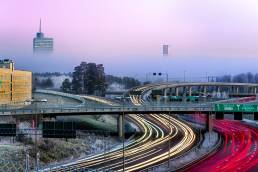
The pilot
The pilot in 2020 was the result of a unique collaboration between some of Sweden’s most prominent and well-known organizations within the fields of mobility and technology.
The knowledge hub and testbed Urban ICT Arena managed the initiative, with Keolis as bus operator. Ericsson provided the technical solution for the connected control tower, a solution that will be further developed during 2021.
Telia provideded the 5G-connectivity in collaboration with Ericsson and deployed 5G at Djurgården specifically for this project. Intel delivered analytics capabilities and the technology for the processing across the network including the IT-system in the vehicles and the control tower, as well as the mobile network. T-Engineering, a Swedish technology firm, delivered vehicle and self-driving technology.
HRH Prince Daniel was among the dignitaries to attend the official inauguration ceremony outside Tekniska museet.
Urban robots and shared micro mobility
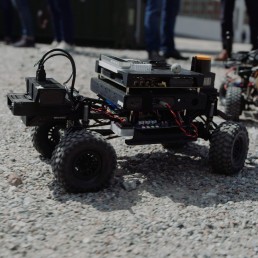
Autonomous vehicles
Urban robots and shared micro mobility
Test & demo activities for Fordonsdalen took off with full speed this earlier this year!
At a demonstration day in June, part of Kista Mobility day 22, smaller growth companies with solutions for autonomous robots and smart city infrastructure were invited to put their innovations on display for a wide audience of decision makers, researchers, public sector representatives and potential business partners in the automotive and ICT industries.
The attendees could dive into cutting-edge solutions aiming to increase the pace of transition, strengthen the innovation power and business development for the city’s mobility systems.
“AI-powered autonomous robots are reshaping urban spaces and city life already today. Cities are at the center of the technological changes fueled by the fourth industrial revolution such as automation and artificial intelligence. We see a rapid development of a range of technologies addressing urban challenges.”
–says Sara Nozkova, Mobility Lead at Kista Science City and project manager for the Test & Demo activities within Fordonsdalen.
The companies demonstrating their solutions in Kista, eg ABConnect and Teraki, showcased how autonomous robots can be integrated into the urban landscape to provide smarter and more sustainable, and effective solutions in many areas, such as last-mile goods delivery, and security tasks.
Collaboration is key
New tech solutions is not all. New solutions for smart infrastructure are needed in order to complement the new first and last mile solutions. Nektta and Livelo are two great example of Stockholm-based companies developing new ways to support people getting around the city in a sustainable way, and to re-think the concepts of shared micromobility. Shared micromobility is an innovative sustainable mode of transport that can replace short-distance travel and has the potential to provide many environmental benefits.
Call for action
Are you too a Stockholm-based small or middle-sized company developing solutions with the potential to transform the automotive industry and transportation system? Would you like to demonstrate your solution to a wider audience, or test together with a potential business partner within the ICT or automotive sector? Do not hesitate to send an e-mail to lucas@uhlen@kista.com
Delta
DELTA
DELTA
DELTA was a pilot project in Kista Science City, organized by Kista Science City, Ericsson, Intel, Keolis and Telia.
The project
The project DELTA explored the possibilites of on demand last mile-solutions as a part of public transport. The electric cars took riders from door to door and connected public transit hubs with destinations within Kista.
The users was able to download an app and then connect with one of the vehicles in Kista. Both the business district (“Kista Science City”) and the residental area was included in the first stage of testing.
Project period
2021
Partners
Keolis
Ericsson
Intel
Telia
Contact
Eleonor Sjödin Turah
eleonor.sjodinturah@kista.com
Summary
The project DELTA explored the possibilites of ridesharing as a part of public transport. The project was centeredd around Kista in northern Stockholm and offer ridesharing "last mile" vehicles free of charge to users in the area.
Starting point: User Experience
Within DELTA, we focused on the user experience in its entirety to investigate and evaluate customer experience with this unique service in order to find out what attributes the service needs to provide to become attractive to the target groups – in other words, what criteria it needs to fulfil in order for customers to choose it over other first/last mile mobility solutions (micromobility) and private cars.
Testing period
The pilot was launched during autumn in 2020 and continued until early December. The project was funded by Drive Sweden and Vinnova.
The future of connected autonomous public transport continues with renewed strength
Nu följer nästa fas i utvecklingen av projektet 5G Ride, och utvecklingen av framtidens kollektivtrafik. Samarbetet kring 5G uppkopplade, självkörande bussar som drivs av Kista Science City, Keolis, Telia, Ericsson, KTH, T-engineering och Intel har fått ytterligare finansiering med 31 miljoner kronor, varav nästan hälften finansieras av Fordonsstrategisk forskning och innovation (FFI), och nya projektpartners i Scania och Viscando.
Future 5G Ride är en utveckling av projektet 5G Ride, som sedan 2020 arbetat med hur man med hjälp av 5G och fjärrövervakning av fordon via ett trafiktorn bidrar till ett smidigt införande av självkörande bussar i en verklig urban miljö.
-Förarlösa fordon har potential att förbättra trafiksäkerheten och effektivisera användningen av våra vägar. En kritisk framgångsfaktor för framtidens kollektivtrafik är hur väl den interagerar med andra tjänster och hur effektiv den är när det finns en blandning av mobilitetstjänster tillgängliga. Genom att utforska möjligheterna som kommer med teknologier som 5G, AI och smarta trafiksensorer ska projektet Future 5G Ride ta ett samlat grepp kring dessa frågor, säger Karin Bengtsson, VD Kista Science City AB.
En viktig nyhet i projektet är nyttjandet av smarta trafiksensorer från Viscando. Sensorerna mäter positioner och banor för alla trafikanter och skickar dessa i realtid till Ericssons innovation cloud, där informationen bearbetas genom att bland annat kombinera informationen med data från andra källor som slutligen delas med det det autonoma fordonet. Fordonet agerar utifrån den sammanlagda bilden, från sensorer, trafiktorn, egna kameror och omgivning. Allt detta i realtid. Informationen från sensorerna förbättrar situationsuppfattningen i komplex trafik avsevärt, fordonet får noggrann information om dolda trafikanter och deras förväntade beteende, vilket gör färden bekvämare och säkrare och tillåter dessutom högre hastigheter. Funktionerna kommer att testas av fordon från Scania och T-engineering
-Att delta i projektet Future 5G Ride tillsammans med ledande industriaktörer i Sverige är ett nytt spännande steg i vår satsning på lösningar för autonom uppkopplad mobilitet. Genom att integrera våra infrastruktursensorer med trafiktornet via snabb och pålitlig 5G länk kan vi möjliggöra delningen av noggrann trafikdata i realtid med självkörande bussar i verklig trafikmiljö – och studera hur denna data kan användas för att förbättra deras situationsuppfattning och göra dem både säkrare och effektivare, säger Amritpal Singh, medgrundare och VD för Viscando AB.
Ambitionen med arbetet är att skapa förutsättningar för en effektiv och hållbar kollektivtrafik där operatörer i trafiktorn kan hantera flottor av autonoma, elektriska fordon för att kunna förbättra trafikplanering och minska energiförbrukning. Genom att ta ett samlat grepp och kombinera teknologier tas nästa steg i utvecklingen av förarlösa automatiserade fordon. Så kan ett mer miljösmart och kostnadseffektivt transportsystem skapas, som känns tryggt och tillgängligt för resenärer.
Att 5G nätens möjligheter med höga datahastigheter, korta svarstider och ökad tillförlitlighet skapar förutsättningar för bussarna att reagera i realtid kunde vi se på höstens demotillfälle där besökare kunde både åka med i bussen och styra via det 5G uppkopplade trafiktornet. Trafiktornet bidrar till utöka säkerhet för både det självkörande fordonet och resenären.
– För oss är den här typen av samarbete viktiga då det ger oss möjlighet att trycktesta 5G och se vad den nya tekniken går för. Att förstå hur nätet hanterar trafiken mellan fordonet och trafiktornet och vad det ställer för krav vad gäller säkerhet och robusthet på de kommunikationslösningar vi levererar till kollektivtrafiken, berättar Magnus Leonhardt, strategi – och innovationschef, Telias företagsaffär.
– KTHs bidrag till projektet är en integrering av ITRLs testbädd för uppkopplade fordon för experimentell forskning om delat sensordata och situationsförståelse, och dess krav på uppkoppling, säger Jonas Mårtensson, föreståndare för KTH ITRL.
– Jag ser fram emot att fortsätta detta spännande projekt. Vi etablerar nu världens första levande 5G labb i Kista som testar nya applikationer för självkörande, uppkopplade fordon och drönare. Med hjälp av innovativ molnteknik, digitala tvillingar i realtid och HD-kartläggning utforskar vi hur man kan öka säkerheten, minska kostnaderna, möjliggöra nya affärsmodeller och göra hållbara transporter till verklighet, säger Stig Persson, programledare, Ericsson.
– Den här typen av projekt, som för samman kärnkompetenser från olika företag och akademi, är en viktig möjliggörare för forskning och utveckling om ny framväxande teknologi. I detta projekt kommer vi att forska om hur sensordata som delas mellan ett fordon och infrastruktur kan användas för att öka perceptionshorisonten och därmed förbättra situationsmedvetenheten. En god situationsmedvetenhet är en nyckelförmåga för säker och effektiv autonom körning, säger Henrik Pettersson, senior teknisk rådgivare, Scania CV.
– Vi ser fram emot fortsätta i detta samarbetsprojekt där vi kommer arbeta vidare med utveckling och utvärdering av framtidens fordons lösningar. Syftet med denna typ av projekt är inte bara att skapa en slutlösning utan att tillsammans lära sig mycket längs vägen och se för och nackdelar med olika tekniker och implementationer. Att framföra en självkörande buss i trafiken är mycket mer än en teknisk och ekonomisk utmaning, det handlar såklart också om att att passagerare måste känna sig trygga och säkra åka med., Sebastian Wallman, Manager Future Mobility, T-Engineering
Projektet sker i ett samarbete mellan några av Sveriges ledande företag inom mobilitet och teknik. Projektet drivs av Kista Science City AB och bussbolaget Keolis. Ericsson bidrar med innovation cloud och de tekniska lösningarna för det 5G uppkopplade trafiktornet och har tillsammans med Telia levererat det 5G-nät som gör att den självkörande fordonet från T-engineering kan rulla vidare. Viscando’s 3D och AI baserade trafiksensorer kommer att förbättra situationsuppfattningen för ökad säkerhet och effektivare framfart. Scania ska utrusta ett fordon för datainsamling och funktionstest samt utveckla och utvärdera situationskännedomsfunktioner baserat på data som skickas från trafiksensorer.
Lessons from the Delta project
The future of mobility will mean new solutions for getting to your destinations. Individual vehicles will become less frequent as we look to more sustainable solutions for mobility, and instead we will see public transport and ridesharing solutions picking up the slack. New solutions for the last mile are launched and tested all the time. One such test was the Delta project in Kista Science City.
The Delta project explored on-demand, last-mile solutions for public transport. Electric cars took users from door to door or connected to public transport hubs in Kista. Booking the ride was done through an app.
As the test was conducted in the autumn of 2020, some constraints had to be added to the test, and the mobility of individuals wasn’t as widespread as usual, but the results are nonetheless promising. In a workshop in January of 2021 the lessons from the tests were presented and we are happy to share them with you.
To set the stage for the project, the projection is that within 10-15 years, connected self-driving vehicles will with all likelihood be a backbone of the modern public transport system. The vehicles used in the Delta project weren’t self-driving, but the concept is made for that context. This also means that when planning new areas for development, preparations should be made both for self-driving solutions in general and ridesharing, on-demand solutions. The latter is something we most likely see more of during those hours where passengers are few and far between, like late nights.
As we look to the lessons learned in the Delta project, we see that the solution tested was mainly used during morning commutes and in the afternoon. As our users were mainly working in Kista, this is not surprising. The commute to and from the workplace, travelling between a public transport hub and the office, seems to be the main reason for utilizing this service. But as this is a last-mile solution, where the alternative to riding is just walking, one thing became evident: having to wait for the ride or not knowing when it would arrive made users cancel their ride. This is important to keep in mind for future implementations of this kind of transport system.
– The on-demand trial from Delta, from technological and customer experience standpoints, is aimed at developing future combined services using free floating on-demand autonomous vehicles, says Sheherazade Zekri, Director New Mobility Services at Keolis.
The big question that needs to be addressed before last-mile solutions of this kind can be rolled out, is the financing. Most users were hesitant to pay for a service like this and wanted it to be included in either the general public transport system, or possibly by their employer or by the real estate company who owns the office building. The business model has been scrutinized and different suggestions have been made, but this is certainly an area that needs to be explored in more detail.
As we look at the bigger picture, with data from a world-wide survey done by Ericsson, we see some interesting patterns in the way people are commuting that fits well with the Delta project and what we learned there. Ride-sharing solutions are popping up in several cities around the globe, and time-efficiency is now the second most important factor when choosing your mode of transportation, after convenience.
The vehicles used for Delta were small, mainly due to the global pandemic putting constraints on how many passengers were prudent to have in one car, but in the evaluations most users were positive to sharing a ride with others. This is something that fits well in with the bigger picture from around the world. Savvy commuters are able to create their own “bubble” while commuting. One large part of this is using digital solutions, listening to music or podcasts, checking social media and so on in order to block out the world around them. This also means that savvy commuters are more satisfied with their commute, even when using traditional modes of public transportation. Being connected in this way also means they are more up to date regarding possible delays or interruptions of services and can more efficiently switch to another mode of transport or take a different route.
– Everyone can relate to the feeling of wasting precious hours every week on a car or a train. So, it is very inspiring to see how some people make the most out of the time when they transition between home and work roles. We have created a unique benchmark to show the benefits of mobile Internet access for a better commuting experience and understand what consumers really want in the future in terms of safety, convenience and entertainment, says Andres Laya, Senior Researcher at Ericsson ConsumerLab.
All in all, attitudes are on the side of the Delta project. Globally, both commuters and city planners agree that ridesharing will contribute to less congestion and reductions of emissions. At the same time, the current opinion is that the private cars will still be needed to some extent, which in part goes against the first opinion. Ridesharing, when it works and is efficient, on-time, convenient and quick will be able to pick up much of the traffic volumes of private cars.
People have come to appreciate the time saved from not commuting every weekday and it is expected that many will continue working from home after the restrictions are lifted. New mobility solutions need to elevate the user experience and allow them to use the travel time to their benefit. For this purpose, connectivity will provide people with the ability to create a better experience for themselves.
Making sure this is the case will be up to projects like Delta.
– The Delta project provided excellent data for how ridesharing last-mile solutions can work in practice and what commuters expect from services like that. It’s been a privilege to assist in this research and the lessons learned have already pointed at some interesting new ways for continued research, development and testing, says Eleonor Sjödin Turah, project manager at Kista Science City.
Testas nu: Ny teknik för framtidens trygga bussresa på självkörande fordon
Innovationsprojektet 5G Ride har testat hur fjärrhantering och nya digitala lösningar kan bidra till en trygg och säker kollektivtrafik med självkörande bussar.
Innovationsprojektet 5G Ride, med deltagarna Urban ICT Arena, Intel, Keolis, Ericsson, T-Engineering, KTH samt Telia utforskar hur 5G, AI och fjärrhantering av fordon via kontrolltorn kan bidra till att underlätta införandet av självkörande eldrivna bussar i stadsmiljöer på ett säkert sätt.
Ambitionen är en effektiv och hållbar kollektivtrafik där operatörer i kontrolltorn kan hantera flottor av autonoma, elektriska fordon för att kunna förbättra trafikplanering och ruttoptimering samt minska energiförbrukning. Det leder till ett mer kostnadseffektivt och miljösmart transportsystem som är mer tillgängligt för invånarna.
Under året har projektet undersökt hur kontrolltornet i kombination med nya digitala tjänster på självkörande bussar kan skapa förutsättningar för en trygg och säker resa för passagerna. Tester har genomförts med självkörande, elektriska fordon i Kista.
– På dagens bussar kan man vända sig till chauffören för hjälp. Det är en trygghet för passagerarna, särskilt för t.ex. äldre. Att man känner sig välkommen och omhändertagen. Med hjälp av ny teknik och kan vi skapa samma upplevelse på självkörande bussar. Det kan handla om att snabbt komma i kontakt med operatörerna i kontrolltorn via enkla digital gränssnitt på bussarna, berättar Jan Jansson, som utvecklar mobilitetstjänster på bussoperatören Keolis.
En annan möjlighet är att med hjälp av AI analysera data från sensorer i bussarna för att proaktivt kunna uppmärksamma operatörerna i kontrolltornet på akuta situationer eller för att identifiera kvarglömda föremål.
Kontrolltornet utvecklas
Förutom att jobba med resan ombord så har även projektet gjort framsteg med att utveckla integrationen mellan kontrolltornet och bussen. Till exempel kan operatören i kontrolltornet ge kommandon till fordonen, och fjärrstyra dem vid behov. Här blir 5G-nätet och dess tekniska egenskaper som snabbhet och korta svarstider viktigt.
Pilottester på Djurgården
5G Ride startade 2020. En viktig milstolpe i projektet var den 24 september samma år då en ny temporär bussrutt invigdes på Djurgården i Stockholm som trafikerades av en eldriven självkörande minibuss uppkopplad mot ett kontrolltorn via 5G-nätet. Projektet kommer fortsätta under kommande år.
Telia invigde Sveriges första storskaliga 5G-nät i maj 2020 i samarbete med Ericsson. Det publika 5G-nätet rullas nu ut runt om i Sverige och kommer täcka mer än 90 % av Sveriges befolkning 2023.
